
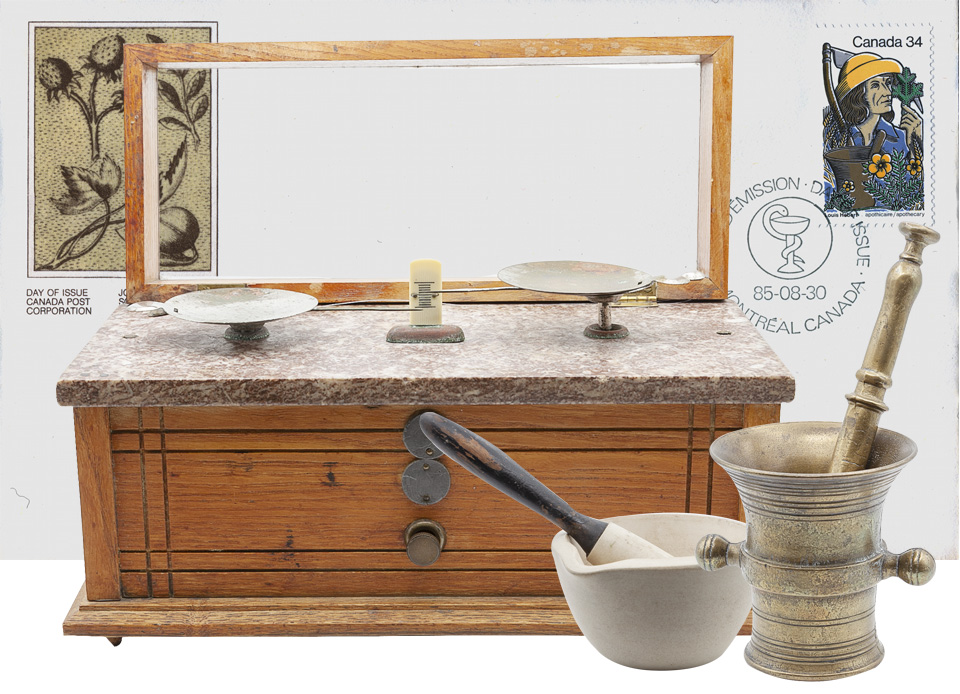
Plants have been used to ease suffering and to cure disease or heal wounds in all cultures since the earliest humans. The most commonly used part has been the leaves, either boiled in water to make an infusion or ground into a salve or poultice to be applied on the skin. Roots, seeds, and flowers, either separately or combined with the leaves, have also been used. Many books documenting such potential uses – called herbals – have been written. The preparation and dispensation of the plant-based medicines were done by a professional apothecary (similar to a pharmacist).
The MAMM collections include a variety of objects related to apothecary practice, including commemorative stamps, balances, mortars and pestles, and medicine bottles. As part of a project sponsored by the Sustainability Projects Fund, herbs known for their presumed medicinal uses,* some for many centuries, were placed in the planters at the entrance of the Strathcona Anatomy and Dentistry Building. The project was done in collaboration with other groups on campus, including the Medicinal Plant Garden, run by the Redpath Museum, located on the Burnside Terrace (south side), and the McGill Herbarium which provided the scans of the dried specimens seen below (some prepared by Andrew Holmes, founder of both McGill’s original medical museum and of the Herbarium).
*Note that the medicinal properties of the plants discussed in this exhibit, despite published or anecdotal reports, are not well-proven. Their use for treating illness or injury is potentially harmful and nothing on this website should be taken as an endorsement to employ them for any medicinal purpose.

The apothecary planters are located at the top of the stairs (east-south side facing the McGill campus) of the Strathcona Anatomy Building.
Achillea millefolium
Yarrow (woundwort, nosebleed, knight’s woundwort, herbe militaris)
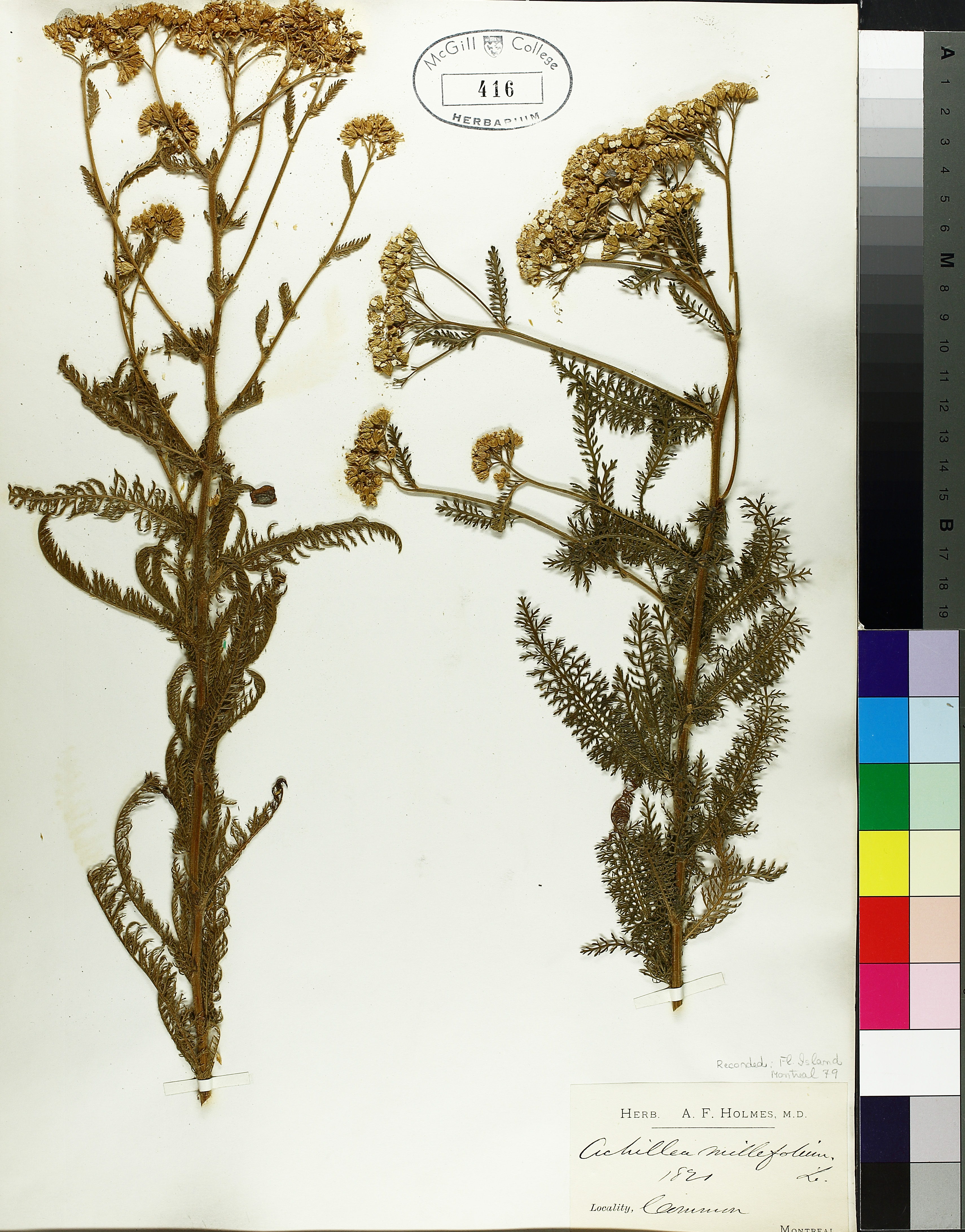
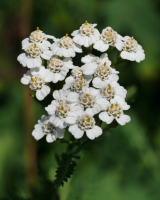
The Plant
- Perennial, 1-3 feet tall;
- Leaves finely divided into numerous leaflets (hence “millefolium”);
- Inflorescence (the arrangement of the flower): 15-20 central cream-colored disk flowers and 3-5 white or pink ray flowers arranged in flat-topped clusters.
Medicinal Properties
The plant has been employed medicinally since ancient times and was listed in De Materia Medica, the famous first-century herbal by Dioscorides. The best and probably longest known use in the Western pharmacopeia has been in poultices to stop bleeding and heal injuries. According to Greek mythology, the centaur Chiron taught Achilles to use it to heal his soldier’s wounds during the Tojan War. In his famous Generall Historie of Plantes, first published in 1597, the herbalist John Gerarde stated: “the leaves of yarrow doe close up wounds, and keep them from inflammation, or fiery swellings”. A more recent reference to this use was in the American Civil War, in which the plant was called “soldier’s woundwort”.
The plant is also indigenous to North America and was widely used by native populations, most often as an infusion derived from the leaves. For example, the Iroquois and the Mohawk are said to have used it to treat “stomach cramps” and diarrhea and the Cheyenne employed it to soothe a cough. The plant contains several potentially active compounds, including salicylic acid and achilleine, an alkaloid that has been shown experimentally to have hemostatic properties.
Aegopodium podagraria
Goutweed (ground elder, bishop’s weed)
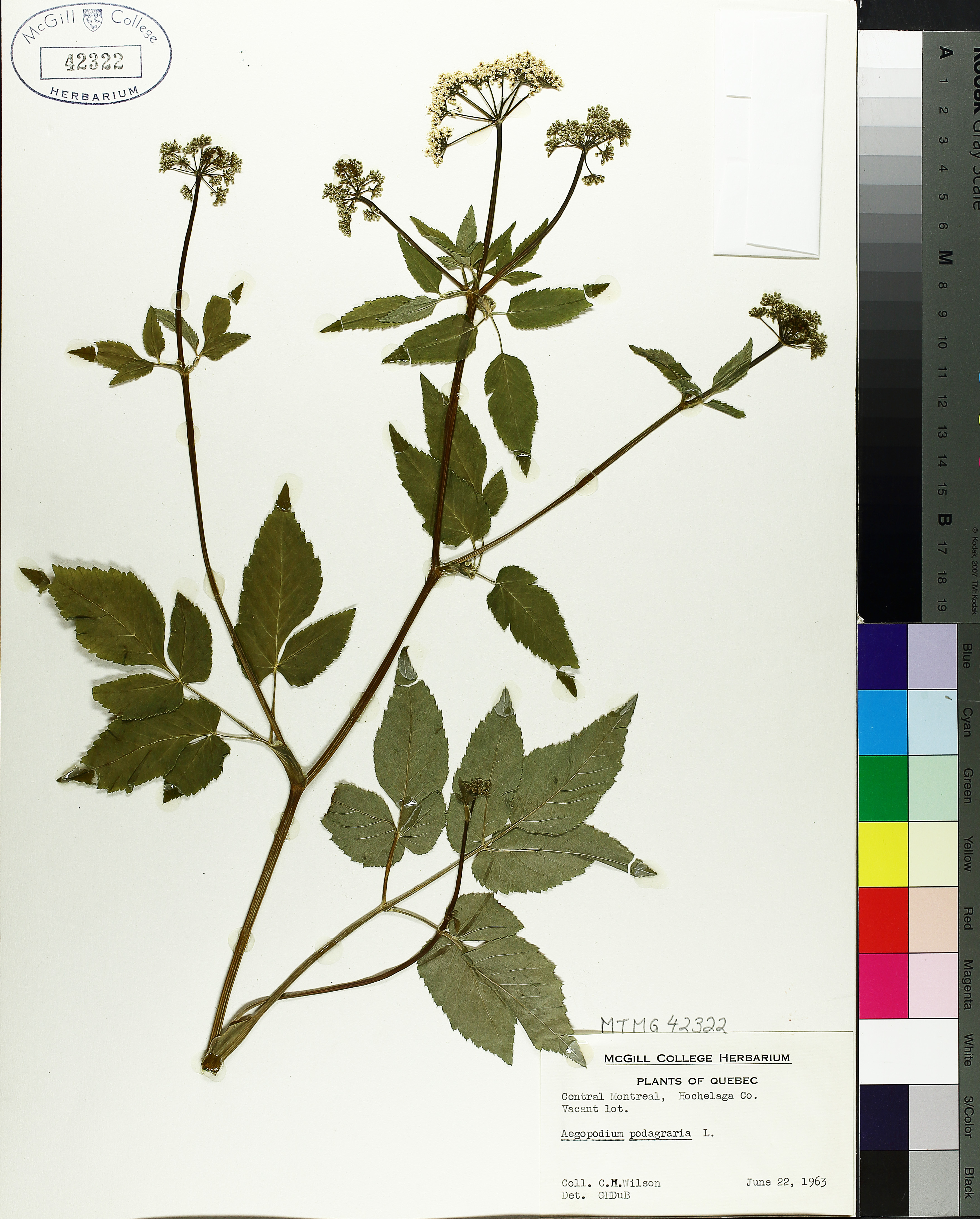
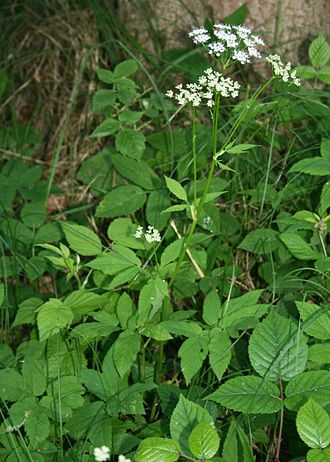
The Plant
- Perennial, 1 – 2 m tall;
- Leaves three-parted, each leaf divided in three;
- Flowers white, in flat-topped clusters at the ends of the stems.
Medicinal Properties
The early spring leaves are edible and were widely used as a “potherb” in the Middle Ages. In fact, this use as well as potential medicinal ones led to it being planted in monk’s gardens (hence “bishop’s weed”). A poultice made from boiled roots and leaves was applied to painful joints such as seen in gout. It is native to mainland Europe and was introduced by colonists to America, probably for its edible or presumed medicinal benefits. The plant grows prolifically next to the Montreal General Hospital and is used to cover land on the University Street side of the Royal Victoria Hospital.
Eutrochium (Eupatorium) purpureum
Sweet-scented Joe-Pye Weed (gravel root, queen of the meadow)


The Plant
- Perennial, 1 – 3 m tall;
- Leaves lance-shaped, in whorls of four on the stem;
- Flowers purple, in somewhat rounded clusters at the ends of the stems.
Medicinal Properties
Tea made from the roots, leaves or flowering heads was used by the Native Americans and European settlers as a diuretic and for the treatment of fever, diarrhea, and rheumatism. The name “gravel-root” refers to its use in treating kidney or bladder stones. Some writers also recommended its use to “dissolve” gallbladder stones.
The plant name has two historical associations. The eponym “Joe Pye” is believed to come from the Mohican leader Schauquethqueat (c1740 - c1785), who lived in Massachusetts and took “Joseph Pye” as his Christian name. He was reputed to have used the plant to cure European settlers of an epidemic of typhoid fever. The plant was catalogued botanically by Linnaeus in the genus Eupatorium, named after Mithradates Eupator, king of Pontus from 120 to 63 BCE. Possibly because his father was murdered, Mithradates studied poisons and their antidotes. His most famous "cure" was to take increasingly large doses of a poison until reaching “immunity” (a procedure known as mithradatism). One of the plants he is purported to have studied for this purpose was Joe-Pye weed.
Prunella vulgaris
Heal-all (woundwort, self-heal, carpenter’s weed)
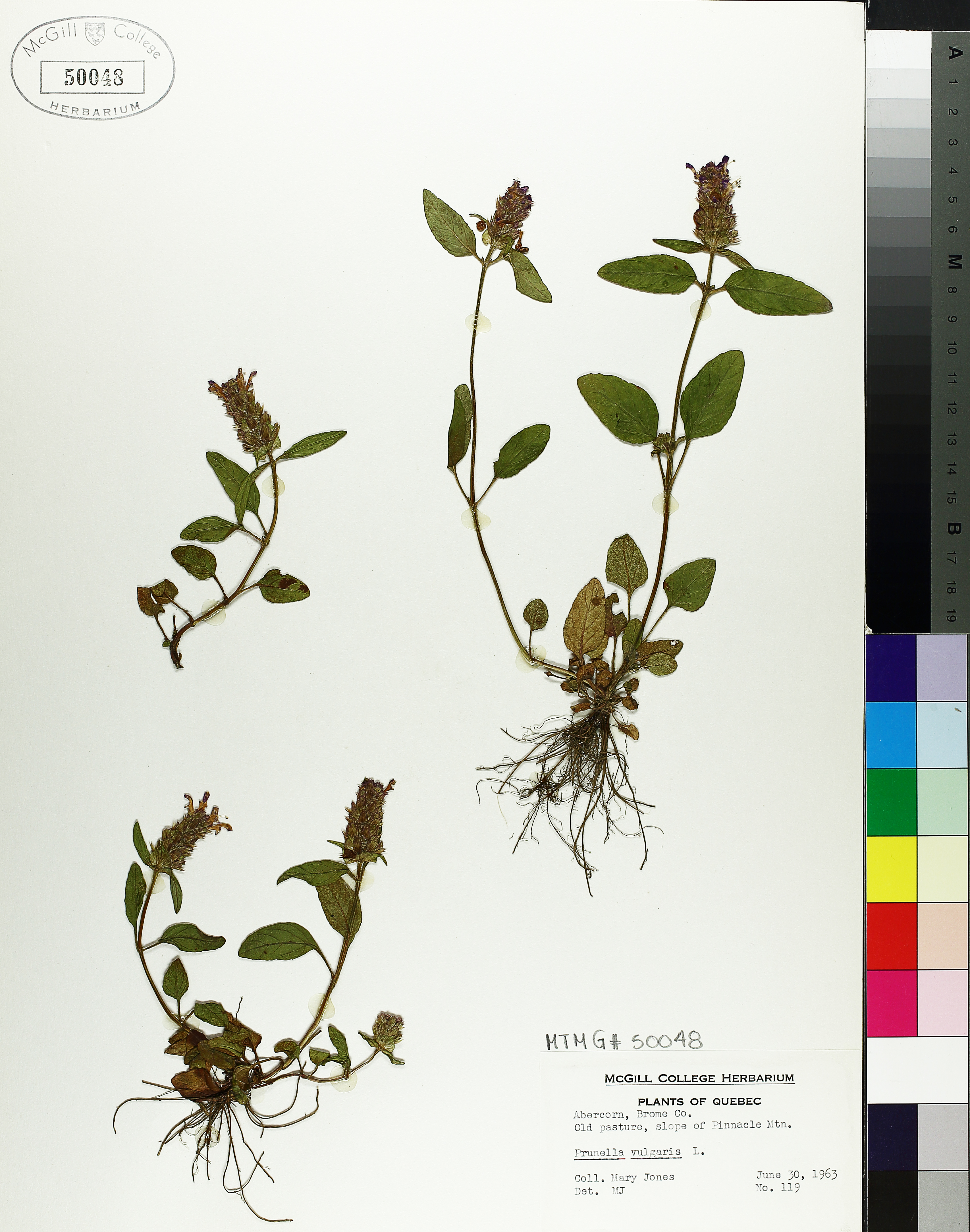
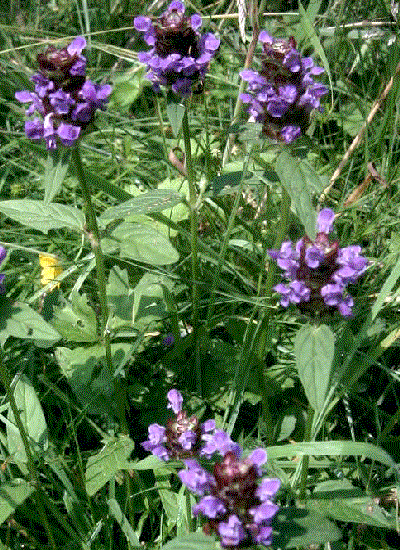
The Plant
- Perennial, 0.5 - 1 feet tall with a creeping stem;
- Leaves opposite, lance-like in shape;
- Flowers purple/blue grouped at the tips of the stems in oblong clusters.
Medicinal Properties
The plant has a long medicinal history. For example, it was mentioned in the Shen Nong herbal compiled in the Han dynasty in China (206 BCE – 23 CE). In traditional Chinese medicine, the dried flower clusters were used for disorders of the liver and as a diuretic.
In medieval European herbalism, the plant was associated more with wound healing and the treatment of throat disease. The generic name Prunella is thought to be derived from “brunella”, in turn originating from the German Braüne, meaning “throat affliction”. Tea made from the leaves was used as a gargle for sore throats and mouth ulcers. In his 1597 herbal, John Gerarde stated that “there is no better wounde herbe in the world”. The reference to "carpenters" in one variant of the common name attests to the belief in its ability to soothe and heal injuries that might be acquired from a hammer or a saw.
Tussilago farfara
Coughwort (coltsfoot, tussilage, pas d’âne)

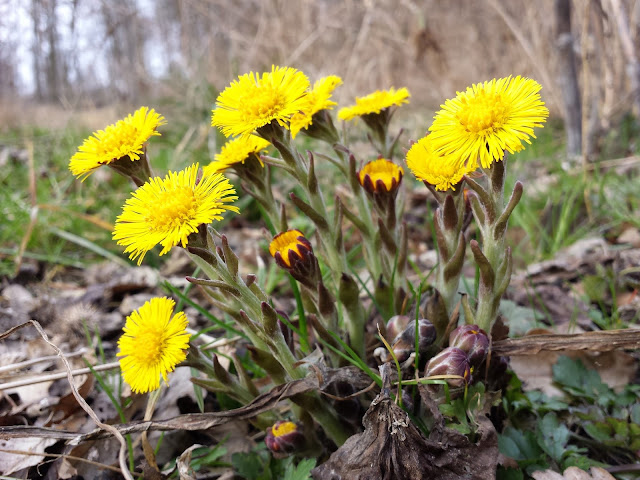
The Plant
- Perennial, 1-2 feet tall;
- Leaves appear after the flowers have wilted, shaped roughly like colt’s or donkey’s hoofs;
- Inflorescence: one of the earliest to bloom in the spring in Montreal, at the end of a solitary stalk covered with red scales. It has numerous central disk and peripheral bright yellow ray flowers. Its seed heads resemble those of the dandelion.
Medicinal Properties
The plant has been employed medicinally since ancient times. The Roman naturalist Pliny the Elder wrote “its root is placed on live coals of cypress wood, and the fumes of it is inhaled through a funnel for chronic cough”. The genus name is derived from the Latin tussis ― cough. An infusion made from the leaves was widely used in Europe in the Middle Ages to suppress cough and to treat asthma and other pulmonary conditions. Syrup derived from boiled roots was used to make cough drops. Its use for these purposes was so well known that reproductions of the leaf were used as an apothecary symbol in France. The plant was introduced to North America by European colonists, possibly to be planted for medicinal use.
